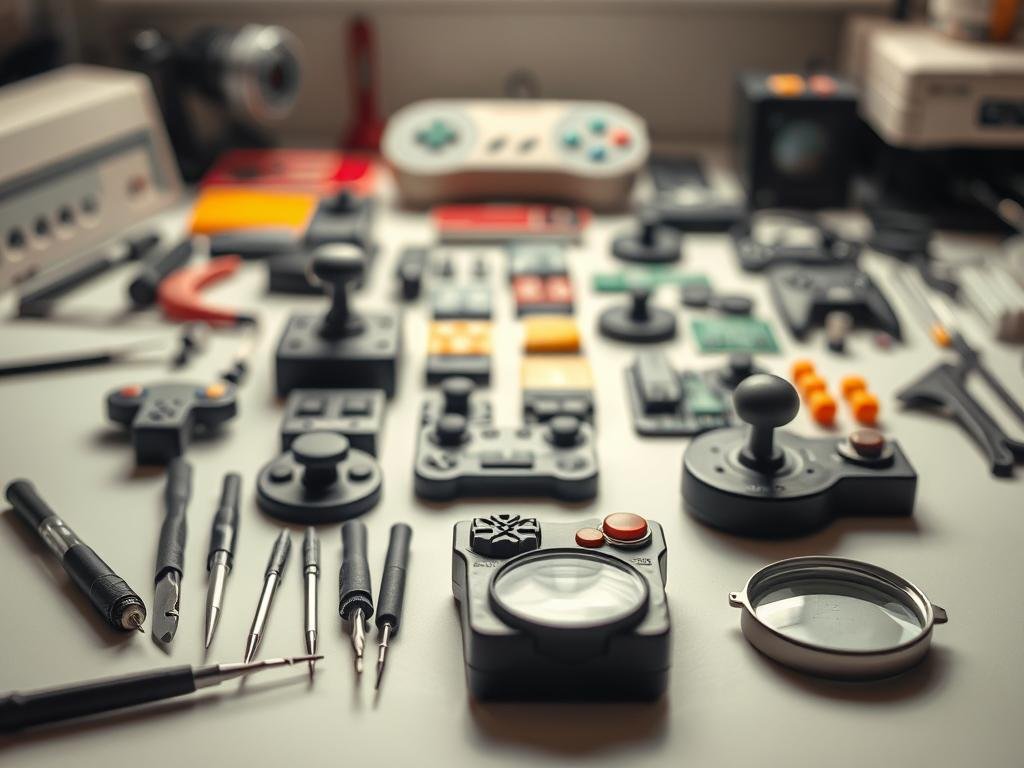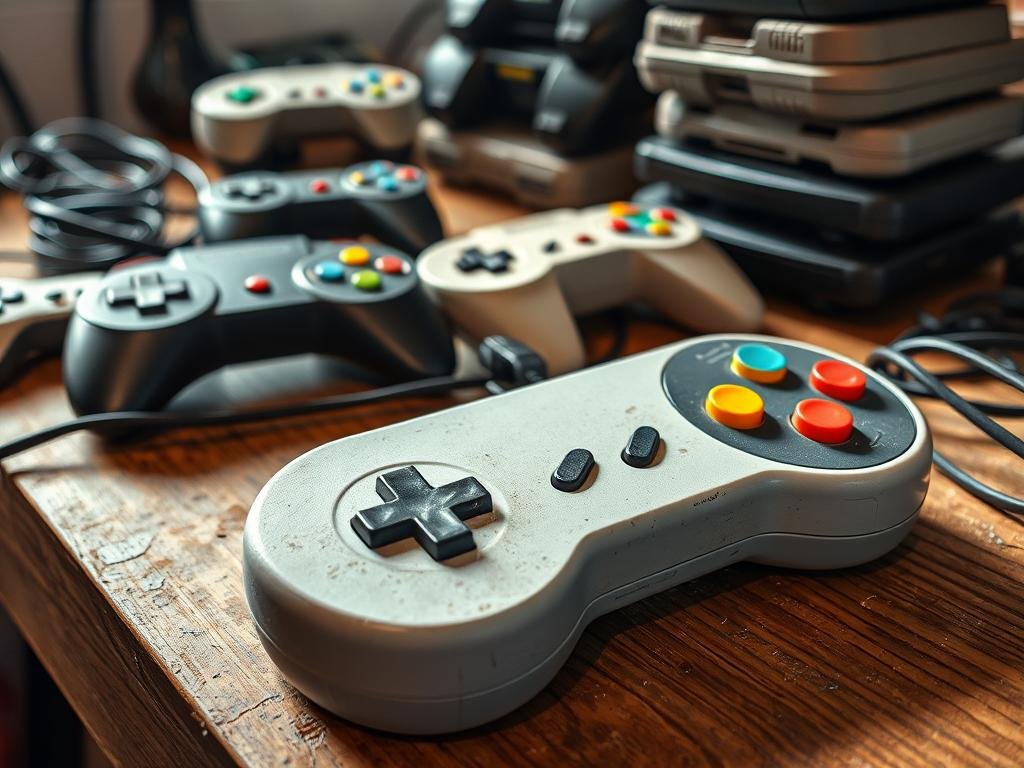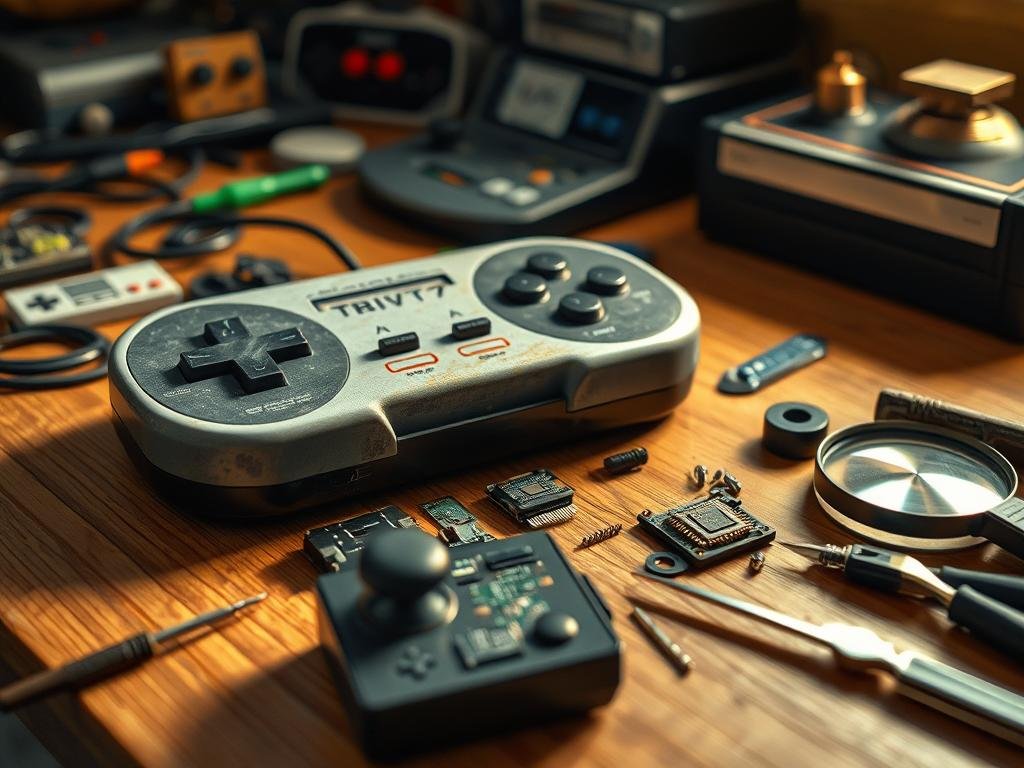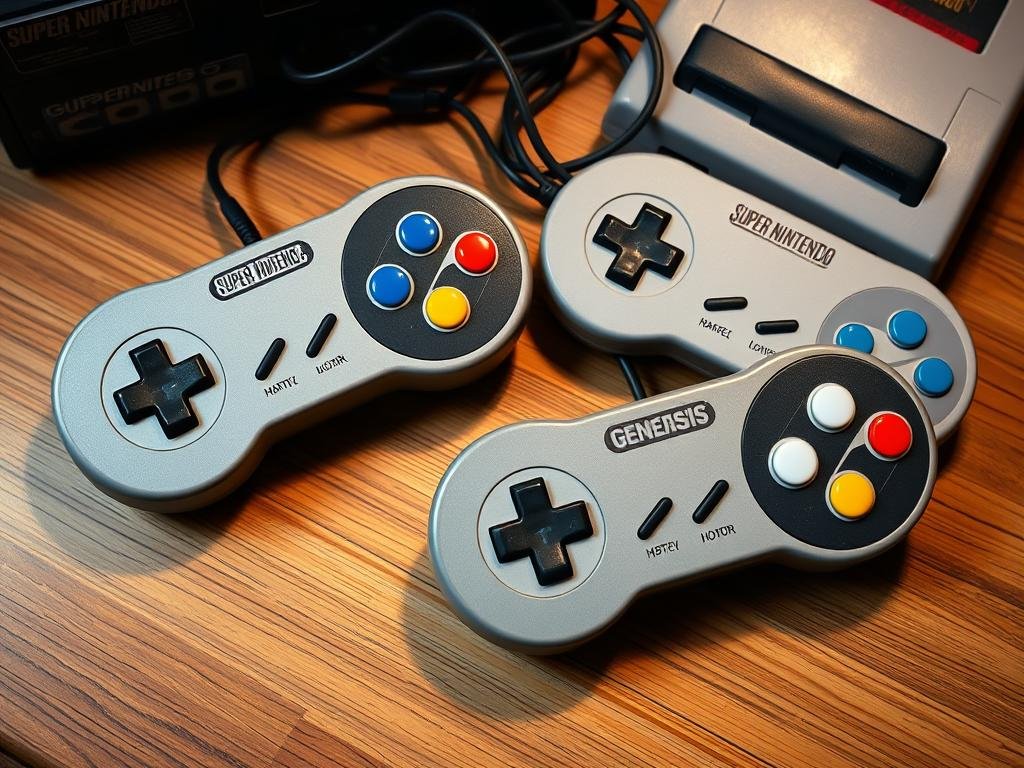Old Video Game Controllers. Did you know a clean retro video game controller can boost your gaming fun? For retro gamers, playing classic games on the original hardware is special. But, the state of your vintage gaming controllers is key to enjoying these games as they were meant.
A great controller is essential for gaming, even more so in retro games where quick actions are vital. Controllers can get dusty and worn out, impacting their performance. By learning to clean and fix your retro video game controllers, you can bring them back to their best. This way, you can keep playing your favorite retro games without any issues. For more detailed repair tips, check out The Art of Retro Game Console.
Key Takeaways
- Regular cleaning can extend the lifespan of your retro controllers.
- Using the right materials, such as Isopropyl alcohol and cotton swabs, is key for cleaning.
- Replacement parts for popular retro controllers are easy to find online.
- Calibration of joysticks and buttons might be needed after repair.
- Good maintenance can greatly improve your retro gaming experience.
Understanding the Need for Cleaning Controllers
Old-school gaming peripherals, like your classic gamepad, need regular care to work right. Dirt, grime, and wear can hurt their performance over time.
When you’re ready to clean your vintage gaming devices, knowing why is key. Dirt and grime can make buttons stick. This can lead to bigger problems if not fixed. For example, finding parts for controllers, like the NES Advantage’s button membranes, can be hard. So, keeping them clean is very important.
Why Cleaning Matters
Cleaning your antique joystick or classic gamepad is more than just making it look good. It’s about keeping it working well. Dirt and dust can get into the controller’s small spaces and break parts. Regular cleaning stops this and keeps your peripherals working right.
- Prevents button stickiness and other mechanical issues
- Reduces the risk of damage to internal components
- Maintains the overall performance of the controller
Game Performance Impact
A dirty controller can really affect how games play. For example, a classic gamepad with sticky buttons can make characters move wrong or actions slow. A guide on how to clean video game controllers shows that cleaning can fix these problems and make games better.
- Dirty controllers can cause lag or delayed responses in games.
- Sticky buttons can lead to repeated or missed actions.
- Poor connectivity can result from dirty ports or connectors.
By knowing how important cleaning is for old-school gaming peripherals, you can keep them working well. This will help you enjoy your games more.
Tools You’ll Need for the Job
Getting the right tools is key for cleaning and fixing collectible console controllers. The right supplies make the job easier and protect your nostalgic video game accessories.
First, you’ll need basic cleaning items. Isopropyl alcohol is great for cleaning electronics. Use a toothbrush to gently remove dirt and grime. Q-tips are perfect for small spots. For the outside, Pledge Electronics or Pledge Multi Surface works well without harming the finish.
Cleaning Supplies
- Isopropyl alcohol
- Toothbrush
- Q-tips
- Pledge Electronics or Pledge Multi Surface
For more details on cleaning and keeping game cartridges in shape, check out this definitive guide. It offers great tips and insights.
Repair Tools
You’ll also need some basic repair tools. A screwdriver set, tweezers, and parts like buttons or cables are essential. These tools help fix any problems with your controllers.

With the right tools and supplies, you’re ready to clean and repair your collectible console controllers. This way, you can enjoy your nostalgic video game accessories for many years.
Step-by-Step Cleaning Process
To make your retro video game controllers shine again, a deep clean is key. This process includes several important steps. These steps can greatly enhance how well your controllers work and look.
Opening the Controller
The first thing to do is open the controller. You’ll need to remove screws from the back or bottom. It’s smart to take a photo of the controller before you start. This will help you remember how it goes back together. For detailed disassembly guides, check out Retro Repairs.
Cleaning the Shell
After opening the controller, clean the shell. Use a soft, damp cloth with Isopropyl alcohol to wipe down both inside and outside. This will get rid of dirt, grime, and old adhesive from stickers. But be careful not to let any liquid get into the electronics.
Cleaning the Buttons
Cleaning the buttons and their parts is vital for them to work right again. Use a toothbrush with Isopropyl alcohol to gently clean the buttons and their contacts. For tough stains or stickiness, you might need to press a bit harder or use a cotton swab for tight spots.
| Component | Cleaning Method | Precautions |
|---|---|---|
| Controller Shell | Soft cloth with Isopropyl alcohol | Avoid getting liquids into electronics |
| Buttons | Toothbrush with Isopropyl alcohol | Be gentle to avoid damaging contacts |
| Electronic Components | Dry cloth or compressed air | Avoid liquids and excessive force |
By following these steps, you can clean your retro video game controllers well. This will make them work better. Regular cleaning also stops problems like sticky buttons and connection issues. So, your vintage gaming controllers will stay in top shape.
Dealing with Sticky Buttons
Sticky buttons on old-school gaming peripherals can be really frustrating. Imagine being in the middle of a game and your classic gamepad stops working because of sticky controls.
Sticky buttons can happen for many reasons. Dirt, spills, or worn-out rubber membranes are common culprits. Knowing why it’s happening helps fix the problem.
Causes of Stickiness
Dirt and grime can make buttons sticky. Sometimes, the rubber membranes under the buttons wear out and get sticky too.
Gaming experts say, “Cleaning well and replacing old parts is key to fixing sticky buttons.”
Effective Cleaning Techniques
To clean sticky buttons, start with compressed air to remove loose dirt. For tougher cases, use a cotton swab with Isopropyl alcohol on the contact points. Boiling water can help firm up soft or sticky rubber membranes.
Be careful when cleaning to avoid harming the buttons or electronics. After cleaning, check if the buttons work right.
By following these steps, you can make your classic gamepad work like new again. This ensures a great gaming experience.
Fixing Faded or Worn-Out Graphics
Faded or worn-out graphics on your collectible console controllers can be fixed easily. Over time, the labels and shells may lose their shine. But, with the right steps, you can make them look new again.

Restoring Labels
Fixing labels needs patience and the right tools. You can use a label restoration kit or a DIY method with a gentle cleaner and soft cloth. For really worn labels, you might need to replace them with new ones that look just like the originals.
- Clean the area around the label gently to remove dirt and grime.
- Apply a label restoration solution or a mixture of water and mild soap.
- For worn-out labels, consider using a label decal or a sticker that matches the original design.
Repainting the Shell
Repainting the controller shell can make it look much better. First, pick a paint that closely matches the original color. Acrylic paint is a good choice because it lasts long and looks great.
- Disassemble the controller to access the shell.
- Clean the shell thoroughly to remove any dirt or oils that might interfere with paint adhesion.
- Apply a primer if necessary, followed by thin coats of paint, allowing each coat to dry before applying the next.
After painting, a clear coat can protect the paint and add shine. Also, using a product like Pledge can help keep the controller dust-free.
Replacing Worn Out Parts
To make your vintage gaming controllers work like new, you need to replace broken parts. Over time, things like buttons, joysticks, and connectors can get damaged. This can make your retro video game controllers not work as well.
Identifying Problematic Components
The first thing to do is figure out which parts are the problem. You might see:
- Buttons that stick or don’t work
- Joysticks that move wrong or don’t move at all
- Connectors that don’t connect right
Looking closely at your controller will show you where the trouble is. For more help, check out Controller Maintenance and Repair.

Finding Spare Parts
After finding the broken parts, you need to find new ones. You can find parts online, made just for your antique joystick or retro controller. Here’s how to find the right parts:
- Look on online marketplaces and forums for retro gaming
- Go to stores that fix electronics or games
- Reach out to the maker if your controller is newer
It’s very important to make sure the new parts fit your controller. This is key for a good fix.
Testing Your Controller After Cleaning
After cleaning and fixing your old-school gaming peripheral, it’s time for a detailed test. This step is key to make sure your vintage gaming controller works perfectly.
Checking Button Response
Start by testing each button on your controller. Press every button several times to see if they stick or don’t work. A good button should work right away and every time. If you find any problems, you might need to clean it again or look for leftover dirt.
- Test the D-pad for smooth navigation.
- Check the face buttons (A, B, X, Y) for responsiveness.
- Verify that the shoulder buttons are functioning correctly.
- Ensure the start and select buttons are working as expected.
Ensuring Connectivity
If your controller has a wire, check the cable for damage. For wireless controllers, make sure the battery connections and the wireless module are clean. Connect your controller to your gaming console to check if it works well.

Tips for a successful test: Play different games to test your controller’s features. For example, a platformer can show if the D-pad or face buttons work right. A game that needs quick timing can check the controller’s overall response.
Common Troubleshooting Issues
Restoring your classic gamepad can lead to some common problems. But, with the right troubleshooting, you can fix them easily. Knowing how to tackle these issues is key to bringing your nostalgic video game accessories back to life.
Controller Not Responding
If your controller won’t respond, there are a few things to check. Corroded battery contacts are a common problem. Cleaning them with vinegar can help. Just use a cotton swab dipped in vinegar to gently rub the corroded spots.
Another issue could be loose connections inside the controller. Over time, these can get loose or corroded. Checking and fixing these connections can often solve the problem.
Connectivity Problems
Connectivity issues can also pop up, often with wired controllers. Look for any damage or wear on the cable. If it’s damaged, you might need to replace it. For wireless controllers, make sure the batteries are in and charged. Also, check for any interference nearby.
- Check for corroded or loose connections within the controller.
- Inspect the cable or wireless receiver for damage.
- Ensure batteries are properly seated and charged.
By tackling these common problems, you can enjoy your classic gamepad just like when it was new. Whether you’re playing on the original console or with a modern TV, a working controller is essential for a great gaming session.
When to Seek Professional Help
DIY repairs can save money, but some retro video game controllers need a pro. If the fix needs special tools or skills, get a pro to avoid more harm.
Signs Your Controller Needs Expert Repair
Some signs show your collectible console controllers need a pro. These include:
- Persistent connectivity issues despite cleaning and troubleshooting.
- Physical damage that requires soldering or advanced repair techniques.
- Buttons or controls that are unresponsive or malfunctioning.
Finding a Reliable Repair Service
Looking for a repair service for your retro video game controllers? Here’s what to consider:
- Find services with experience in vintage gaming consoles.
- Check reviews and testimonials from past customers.
- Ask about their warranty or guarantee on repairs.
Choosing a trusted repair service ensures your collectible console controllers are fixed right.
Maintaining Your Controllers for Longevity
Proper care and maintenance can make your vintage gaming controllers last longer. By following a few simple tips, you can keep your old-school gaming peripherals in top condition. This ensures they continue to function optimally.
To maintain your vintage controllers, it’s essential to store them properly. Here are some best practices for storage:
Best Practices for Storage
- Store your controllers in a cool, dry place away from direct sunlight.
- Avoid storing controllers in humid environments or areas prone to moisture.
- Use protective cases or bags to prevent dust and debris from accumulating on the controllers.
- Consider storing controllers in a climate-controlled environment to prevent damage from extreme temperatures.
For more information on maintaining your gaming controllers, you can check out this guide on increasing the lifespan of your PlayStation or Xbox.
Regular Cleaning Tips
Regular cleaning is key to keeping your vintage gaming controllers in good shape. Here are some tips to keep your controllers clean:
| Cleaning Method | Description | Frequency |
|---|---|---|
| Soft Cloth Cleaning | Gently wipe down the controller with a soft, dry cloth to remove dust and debris. | Weekly |
| Deep Cleaning | Use a mild cleaning solution and a soft-bristled brush to clean hard-to-reach areas and stubborn stains. | Monthly |
| Button Cleaning | Use compressed air to clean between buttons and a cotton swab to clean the button surfaces. | Bi-Weekly |
By following these simple maintenance tips, you can extend the life of your vintage gaming controllers. This way, you can continue to enjoy nostalgic gaming sessions.
Upgrading Old Controllers with Modern Modifications
You can give your nostalgic video game accessories a new life with modern upgrades. This makes your gaming better and keeps the classic look of your old controllers.
As gaming tech gets better, you can add new features to your old joystick. This makes it more fun and useful to use.
Adding Wireless Capabilities
One big upgrade is making your old controllers wireless. This gets rid of cables and makes gaming more flexible. “Wireless gaming is the future,” say gamers, and it’s now possible for old controllers too.
To do this, use wireless kits made for retro gaming consoles. They’re easy to set up and make your gaming setup better.
Custom Button Layouts
Customizing button layouts on your controllers is another cool change. It makes playing games more intuitive. Custom layouts are great for games that need complex button presses.
By changing or rearranging buttons, you can make your controllers feel new again. But they’ll keep their classic charm.
Upgrading your old controllers keeps their function alive and honors classic gaming. With these updates, you can enjoy your favorite old games in a new way.
Conclusion: Enjoying Nostalgia with Functional Controllers
Cleaning and fixing your retro video game controllers brings back great gaming memories. It makes your gaming experience better. Plus, it keeps the history of consoles like the SNES and Mega Drive alive.
Key Steps Recap
You’ve learned how to clean and fix your controllers. You can now restore faded graphics and replace old parts. These steps keep your controllers in great shape.
Preserving the Legacy
Keeping your vintage controllers working means you can play your favorite retro games again. It’s also a way to keep gaming history alive. This lets you see how gaming technology has changed over time.
With these easy steps, you can enjoy your retro controllers for many years. It keeps the nostalgia alive and your gaming sessions going without a hitch.
FAQ
What are the most common issues with old video game controllers?
Old video game controllers often face problems like dirt buildup, sticky buttons, and worn parts. These issues can make playing games less enjoyable.
How do I clean my vintage retro video game controllers?
Begin by taking apart your controllers. Use a soft-bristled brush and a gentle cleaning solution to clean the exterior and buttons. Make sure to dry everything well before putting it back together.
What tools do I need to repair my classic gamepad?
You’ll need screwdrivers, a soft-bristled brush, cleaning solution, and new parts like buttons or joysticks. A soldering iron might also be necessary for fixing worn-out parts.
Can I upgrade my old-school gaming peripherals with modern features?
Yes, you can add modern features to your old-school gaming peripherals. This could include wireless connectivity or custom button layouts. It can make your vintage controllers more useful and fun.
How do I maintain my collectible console controllers to ensure they remain in good condition?
Keep your collectible controllers in a cool, dry place, away from sunlight. Clean them regularly with a soft-bristled brush and mild solution. Avoid extreme temperatures or humidity.
What are the signs that my antique joystick needs professional repair?
If your antique joystick has issues like unresponsive buttons or faulty connections, it might need a pro. Also, if parts can’t be replaced, it’s time for professional help.
Can I restore the aesthetic appeal of my vintage gaming controllers?
Yes, you can make your vintage controllers look new again. Try repainting, restoring faded labels, or replacing old parts with new ones. This will enhance your gaming experience.
How do I test my vintage controller after cleaning and repair?
After cleaning and repair, test your controller. Make sure all buttons work, connections are stable, and it’s functioning right. Plug it into your console and play a game to check.
